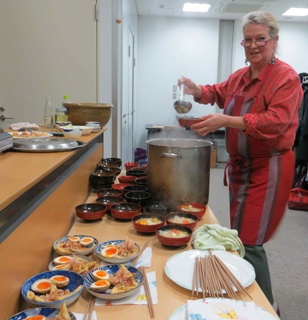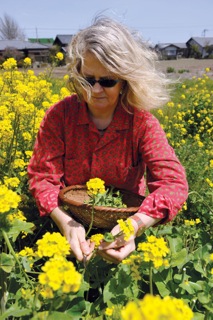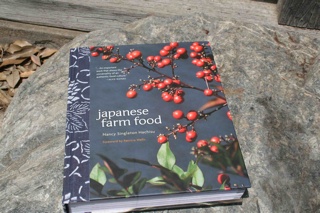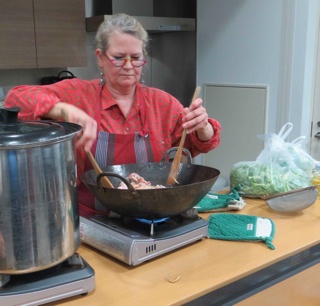February 18, 2013
Good Farm Food: Nancy Singleton Hachisu Cooks for SWET
 “I communicate through food,” said Nancy Singleton Hachisu, so she brought her food from the countryside of Saitama prefecture to the kitchen-equipped meeting room of the Wesley Center in Minami Aoyama and cooked for 31 SWET members and their friends on a cold late-January Friday night.
“I communicate through food,” said Nancy Singleton Hachisu, so she brought her food from the countryside of Saitama prefecture to the kitchen-equipped meeting room of the Wesley Center in Minami Aoyama and cooked for 31 SWET members and their friends on a cold late-January Friday night.
Sunny-yellow “soy sauce marinated eggs” and tasty, tangy “grilled tofu pouches with ginger and scallions,” both recipes in her recently published Japanese Farm Food cookbook (Andrews McMeel Publishing), were our appetizers as we began catching up with old SWET friends and making new ones. The gentle aromas of freshly made dashi, cooking vegetables, and crushed sesame filled the building, causing people of other groups to peer in our door and gaze longingly at the sign for our event. Hachisu ladled out 31 dishes of steaming miso soup, and the assembled diners savored the organically grown yellow and red carrots, daikon, and negi, garnished not just with scallions but also aromatic yuzu peel, and the soup made with miso Hachisu especially recommends, made by the Yamaki organic soy sauce and miso makers in her part of Saitama.
Two more of Nancy's favorite recipes, Carrot and Mitsuba Salad with Citrus, and for Pork and Flowering Mustard Stir-fry, are provided here for you to try and enjoy.
 Hachisu then took off her apron to talk about her book, as a slideshow flashed images of her life on the farm, her cooking, the people who nurture her passion for food, and the ingredients that inspire her. She has done her apprenticeship and more in the culture of Japanese food, learning from her mother-in-law and her husband, and pursuing her passion for flavor and genuine goodness all over the United States, in Paris, and in Italy.
Hachisu then took off her apron to talk about her book, as a slideshow flashed images of her life on the farm, her cooking, the people who nurture her passion for food, and the ingredients that inspire her. She has done her apprenticeship and more in the culture of Japanese food, learning from her mother-in-law and her husband, and pursuing her passion for flavor and genuine goodness all over the United States, in Paris, and in Italy.
She talked about the cookbook, Japanese Farm Food, which has already sold more than 20,000 copies and continues to be in demand, though it is clearly inseparable from her family, her business (an English immersion school for preschool kids), and the way that living in Japan has broadened and inspired her. She had toyed with the idea of writing a cookbook for several years and to improve her writing participated in online writing courses, which began to bear fruit in articles, essays and eventually, a blog about her passion—good, country-style cooking. “I wanted to do whatever I could to improve the quality of my writing,” she said, for her own voice was starting to speak out from her keyboard.
 That voice was eventually heard by veteran editor Kim Schuefftan, a founding member of SWET who now edits, writes, and advises authors from his farmhouse in the mountains of Gunma prefecture, by serendipity not far from where Hachisu lives. Wise from 40 years of shepherding fine books about not just cooking but every other imaginable aspect of Japanese culture into print, Schuefftan told her: “You’ve got a book in you.”
That voice was eventually heard by veteran editor Kim Schuefftan, a founding member of SWET who now edits, writes, and advises authors from his farmhouse in the mountains of Gunma prefecture, by serendipity not far from where Hachisu lives. Wise from 40 years of shepherding fine books about not just cooking but every other imaginable aspect of Japanese culture into print, Schuefftan told her: “You’ve got a book in you.”
After meetings with agents and advisors, and work with photographer Kenji Miura, Hachisu began to write her book proposal, a 75-page opus. Later, her proposal would keep her steady and on course as she strove to write her manuscript in that anguished period during and following the March 11, 2011 disaster.
Subsequent steps of the publishing process continued through 2011 and early 2012, with the author herself revising and editing over and over at each stage in the copyediting, layout, and proofreading processes, and selecting photographs, checking and testing recipes, and working with the designers. The account gave us glimpses of the often-tortuous saga that an author knows so intimately but which shows no trace in the completed book.
Japanese Farm Food is to be coveted for many reasons other than its recipes. The spine, wrapped in a band printed with an indigo folk cloth pattern of chrysanthemum arabesques, and the cover, striking with its colors of red and dark blue, reaches out to you. Each chapter spread features photographs set off with bands of fabric patterns, the Japanese for the content written vertically by the author’s husband, Tadaaki Hachisu.
 Hachisu’s farm-fare meal brought SWET her embrace of the genuine and natural and her insistence on healthy and local ingredients selected from organic farmers’ fields, seasoning using products of manufacturers she personally knows and trusts. We did not use paper plates or disposable chopsticks; from the stash that is quite ordinary for a large country farm family, she brought stacks of ceramic plates and lacquer soup bowls, as well wooden reusable chopsticks. The communion with good food is even better when properly served. That additional message in this event was all made possible thanks to Kim Schuefftan, who drove the cook and her equipment to Tokyo and to Hachisu family friend Mei Tachihara who assisted and washed dishes efficiently and inconspicuously behind the scenes. If of late we had been feeling turned into robots by Internet technology and the race for ever-faster, ever-cheaper wordsmithing, Nancy Singleton Hachisu’s presence among us was a burst of energy that encourages and nudges us out of our rut.
Hachisu’s farm-fare meal brought SWET her embrace of the genuine and natural and her insistence on healthy and local ingredients selected from organic farmers’ fields, seasoning using products of manufacturers she personally knows and trusts. We did not use paper plates or disposable chopsticks; from the stash that is quite ordinary for a large country farm family, she brought stacks of ceramic plates and lacquer soup bowls, as well wooden reusable chopsticks. The communion with good food is even better when properly served. That additional message in this event was all made possible thanks to Kim Schuefftan, who drove the cook and her equipment to Tokyo and to Hachisu family friend Mei Tachihara who assisted and washed dishes efficiently and inconspicuously behind the scenes. If of late we had been feeling turned into robots by Internet technology and the race for ever-faster, ever-cheaper wordsmithing, Nancy Singleton Hachisu’s presence among us was a burst of energy that encourages and nudges us out of our rut.
What speaks to SWET about Japanese Farm Food is much more than its making as a published cookbook; it is about sticking up for the principles you treasure, for letting yourself be passionate about what you really care about. The book is a fabric interwoven with family, friends, colleagues, and experiences—the stuff that holds the community of SWET together as well. What better way to start off a new year, SWET’s 32nd year, cherishing our connections, sharing what we know, and opening up new horizons of our knowledge and craft.
Lynne E. Riggs
2013 New Year’s Party Organizer
Postscript Rambles of an Involved Observer
Nancy’s odyssey in committing to this project, writing the 75-page proposal (inconceivable in my publishing years with Kodansha International), hiring an agent and publicist, finding a publisher, then undergoing the ups and downs, the battles won and compromises made, the depressions and elations, strengthened her psychic muscles.
SWET members who publish abroad are well acquainted with the problems encountered when publishing staff are unacquainted with Japan. Nancy was lucky in having an editor with three years of Japan residence and a vigorous interest in its culture. Later, with the proofreaders, this luck flagged considerably and her reserve of patience was…er…tested.
The publisher gave Nancy the opportunity—a rather unusual one—for a loud voice in design decisions, and Nancy put some force into her stated desire to let Japanese honest folk (mingei) textiles talk in the book. They speak loud and clear. The fabrics used in the design are almost all Japanese folk textiles, mainly indigo. Most of them are from Nancy’s collection, which she has garnered from the Sunday antique/flea/anything market held about two-minutes walk from her house. The plates and vessels and other food-related objects also came from the market. It should be noted that Tadaaki, Nancy’s husband, is a fine amateur potter, as is her son Christopher, and bowls and cups made by these two are seen here and there in the photos. The calligraphy is by Tadaaki.
Nancy’s strength was apparent at the SWET gala, though working in a no-frills office kitchen—in the seemingly effortless presentation, smooth preparation of food for 31 people, and the relaxed, lively, and honest narrative of the book writing/publishing experience enriched by flashing slides of events and people along the road. Attendees went traveling through Nancy’s world, and enjoyment was evident. And quite a few books were sold.
In this, her ambitious first book, Nancy plunged into the adventure in learning and stretching and growing. (Maybe, probably, a Big First Book is a path to follow?) But a book that sings, as with good music and art, etc., has to get born because it has to get born. An author, a composer, a painter is a convenient tool whose talents get utilized and exploited by the work that is produced. (That statement should get some interesting reactions.) Nancy’s book tapped her on the shoulder and said, “Write me. You are the only one who can.” The truth of this is evidenced by the fact that Japanese Farm Food was sown in and harvested from the Japanese countryside by someone close enough and far enough away to savor and see and be enchanted. That enchantment resonates and is an oblation to the world.
Kim Schuefftan
Editor
